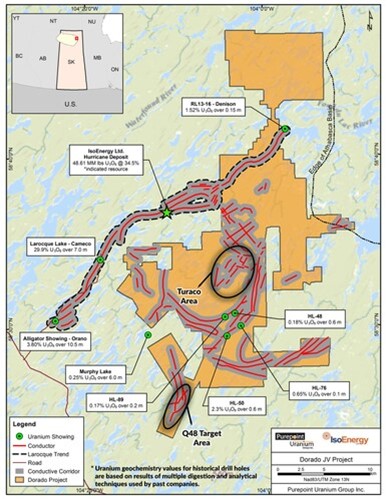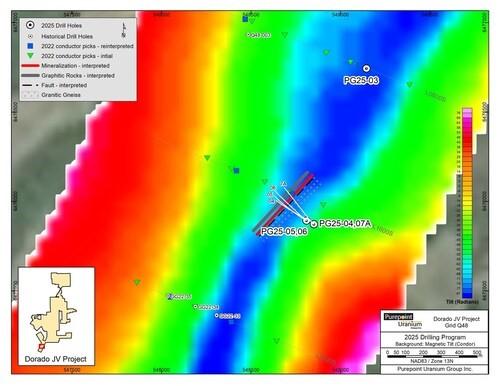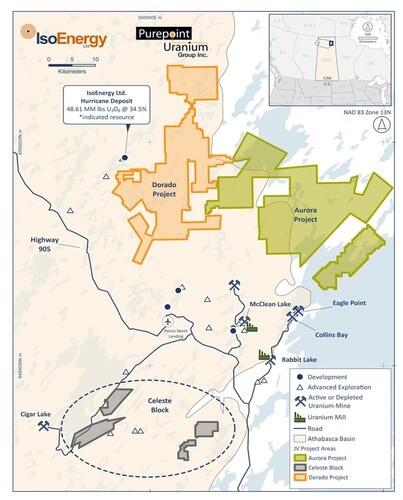
IsoEnergy and Purepoint Extend High-Grade Mineralization at the Dorado JV with a 70 Metre Step-Out Peaking at 110,800 CPS
IsoEnergy Ltd. (NYSE: ISOU) (TSX: ISO) and Purepoint Uranium Group Inc. (TSX-V: PTU) (OTC: PTUUF) are pleased to report continued strong results from drilling at their 50/50 Dorado joint venture project, located in Saskatchewan’s world-class Athabasca Basin (Figure 1). The most recent drill hole, PG25-07A, stepped out approximately 70 metres northeast of the “Nova Discovery” intercepts at the Q48 target area and returned stronger mineralization, with an average of 11,100 counts per second (CPS) measured on a Mount Sopris 2PGA-1000 downhole radiometric probe across a much wider interval of 14.0 metres, including a peak reading of 110,800 CPS.
The recent Nova Discovery results further define the mineralized trend at the Q48 target as a steeply dipping, uranium-bearing structure hosted within the basement rocks, underscoring the potential scale and strength of the system emerging at Dorado. All assays from the current program, including holes PG25-04 and PG25-05, are pending on a rush basis and will be disclosed once available.
Highlights
- PG25-07A intersected a continuation of the Nova Discovery uranium basement hosted mineralization approximately 70 metres northeast of PG25-05 and 60 metres below the unconformity, averaging 11,100 CPS over 14.0 metres with a peak of 110,100 CPS.
- The Nova Discovery mineralization at Q48 remains open to the northeast, the direction of increasing radioactivity, but wet marsh ground conditions currently prevent further drilling in that direction. Follow-up drilling is expected to resume this winter, when frozen ground allows for more efficient land-based access.
- The drill rig has now been mobilized to the Turaco target, located approximately 8 km northeast of the Q48 target within the Dorado project. Up to four holes are planned at Turaco as part of the 5,400-metre drill program approved by the joint venture partners for 2025.
“The recent Nova Discovery results underscore just how much potential remains at Dorado,” said Chris Frostad, President and CEO of Purepoint Uranium. “PG25-07A has successfully extended the Nova Discovery zone by 70 metres and delivered our strongest intercept to date, both in intensity and thickness based on radioactivity. The systematic way we’ve approached Q48 is paying off, and we expect the next phase of drilling will push this discovery even further.”
“The results from PG25-07A mark a significant leap forward for our new Nova discovery,” added Philip Williams, CEO and Director of IsoEnergy. “This step-out hole shows that the mineralized structure continues northeast and that the grades and thickness are improving as we move along the trend. While we have had to pause advancement in this direction due to ground conditions, we are eager to return this winter to continue following what we believe is shaping up to be an exciting discovery.”
DDHs PG25-06 and PG25-07A
Drill hole PG25-06 targeted the brittle fault associated with mineralization (Figure 1) at the unconformity approximately 20 metres northeast of initial drilling (Figure 2). The drill hole was collared with a dip of -64 degrees and encountered Athabasca sandstone to a depth of 316 metres. Granitic gneiss displaying paleoweathering alteration was drilled to 341 metres then generally unaltered granite, pegmatites and pelitic gneiss was drilled to the completion depth of 482 metres. Projection of the Nova Discovery zone mineralization suggests the radioactive sandstone interval of 1,040 cps over 2.3 metres in the Mount Sopris 2PGA-1000 downhole gamma probe (Table 1), which occurs within core lost between 312.4 to 314.0m, is related to the primary mineralized structure.
Hole PG25-07A was collared from the PG25-04 drill pad and initial deviation resulted in a large 70 metre step out to the northeast of the PG25-05 mineralized intercept. The unconformity was intersected at a depth of 322 metres and the drill hole intercepted the radioactive structure approximately 40 metres up-dip of PG25-04. From the unconformity, granitic gneiss with pegmatitic intervals was encountered to a depth of 392 metres that was initially clay altered for 5 metres, weakly chlorite altered for 20 meters, unaltered for 36 metres, then became chloritized and silicified for 9 metres. Chloritized pelitic gneiss was drilled from 392 to 441 metres, unaltered graphitic and pyritic pelitic gneiss to 459 metres, followed by unaltered granitic gneiss and pegmatites with minor pelitic gneiss to the completion depth of 548 metres.
The PG25-07A Nova zone mineralization starts within granitic gneiss at 382.3 metres and extends into pelitic gneiss to a depth of 396.3 metres returning an average of 11,100 cps over 14.0 metres. A primary mineralized structure of the Nova zone is hosted in sheared, reddish-brown altered granitic gneiss with pitchblende that returned an average of 82,300 cps over 0.6 metres with a peak of 110,800 cps. A second strongly mineralized interval occurs within lost pelitic gneiss core and returned an average of 46,000 cps over 0.4 metres.
* See Qualified Person Statement below.
Table 1: Downhole Gamma Results of Drill Holes PG25-06 and 07A
| Hole ID | From (m) | To (m) | Length (m) | Avg. cps | Max. cps |
| PG25-06 | 250.8 | 251.5 | 0.7 | 665 | 805 |
| 312.6 | 314.9 | 2.3 | 1,040 | 1,770 | |
| 341.2 | 345.3 | 4.1 | 980 | 1,980 | |
| 347.6 | 348.4 | 0.8 | 860 | 1,060 | |
| 351.4 | 353.1 | 1.7 | 910 | 1,320 | |
| 403.3 | 404.7 | 1.4 | 1,410 | 2,600 | |
| PG25-07A | 382.3 | 396.3 | 14.0 | 11,100 | 110,800 |
| Includes | 385.5 | 386.1 | 0.6 | 82,300 | |
| Includes | 392.3 | 392.7 | 0.4 | 46,000 | |
| 397.4 | 399.8 | 2.4 | 4,500 | 20,200 | |
| 401.5 | 402.8 | 1.3 | 6,200 | 21,500 | |
| Includes | 402.0 | 402.4 | 0.4 | 14,400 | |
| 484.4 | 484.9 | 0.5 | 1,720 | 3,680 |
Note: Mt. Sopris 2PGA probe used to record downhole gamma readings
Q48 Target Area
The Q48 zone lies within the southern portion of the Project and is characterized by a steeply dipping, north-south trending conductive package identified through geophysical surveys. Historic drilling in the area intersected strongly altered and structurally disrupted rocks at the unconformity and in the basement, including garnetiferous pelitic gneiss, graphitic pelitic gneiss, and semipelite, with local weak radioactivity and zones of intense clay alteration. These results, combined with the geophysical response, highlighted Q48 as a highly prospective but underexplored target.
Drilling by IsoEnergy in 2022 confirmed that the conductive trend at Q48 hosts brittle faults, shears, and alteration, characteristics of uranium-bearing hydrothermal systems in the Athabasca Basin. The current program is designed to systematically follow-up and fully test the Q48 conductive corridor.
Turaco Target Area
The Turaco zone lies within the central portion of the Project and is characterized by a broad area with high conductivity. Although numerous geophysical surveys have been conducted, including airborne electromagnetics (VTEM), ground EM, induced polarization and gravity, previous drilling has failed to properly explain the interpreted EM conductors. A recent review of the geophysical results by Condor Consulting North of Vancouver, BC has selected alternative EM conductor picks that better explain the conductive responses and used Maxwell Modeling to accurately locate the position of discreet conductors. Drilling will commence at one of the high priority target areas identified by Condor.
About the Dorado JV Project
Dorado (Figure 3) is the flagship project of the IsoEnergy-Purepoint 50/50 joint venture, a partnership encompassing more than 98,000 hectares of prime uranium exploration ground. The Project includes the former Turnor Lake, Geiger, Edge, and Full Moon properties, all underlain by graphite-bearing lithologies and fault structures favorable for uranium deposition.
Recent drilling by IsoEnergy east of the Hurricane Deposit has intersected strongly elevated radioactivity in multiple holes. The anomalous radioactivity confirms the continuity of fertile graphitic rock package and further highlights the opportunity for additional high-grade discoveries across the region.
The shallow unconformity depths across the Dorado property—typically between 30 and 300 metres—allow for highly efficient drilling and rapid follow-up on results.
* See Qualified Person Statement below.
Gamma Logging and Geochemical Assaying
A Mount Sopris 2PGA-1000 downhole total gamma probe was utilized for radiometric surveying. The total gamma results provided in Table 1 were selected using a cutoff of 500 cps over a 0.5 metre width. All drill intercepts are core width and true thickness is yet to be determined.
Core samples are submitted to the Saskatchewan Research Council (SRC) Geoanalytical Laboratories in Saskatoon. The SRC facility is independent of IsoEnergy and PurePoint and is ISO/IEC 17025:2005 accredited by the Standards Council of Canada (scope of accreditation #537). The samples are analyzed for a multi-element suite using partial and total digestion inductively coupled plasma methods, for boron by Na2O2 fusion, and for uranium by fluorimetry.
Qualified Person Statement
The scientific and technical information contained in this news release relating to IsoEnergy and Purepoint was reviewed and approved by Dr. Dan Brisbin, P.Geo., IsoEnergy’s Vice President, Exploration and Scott Frostad BSc, MASc, P.Geo., Purepoint’s Vice President, Exploration, who are “Qualified Persons” (as defined in NI 43-101 – Standards of Disclosure for Mineral Projects.
For additional information with respect to the current mineral resource estimate for IsoEnergy’s Hurricane Deposit, please refer to the Technical Report prepared in accordance with NI 43-101 entitled “Technical Report on the Larocque East Project, Northern Saskatchewan, Canada” dated August 4, 2022, available under IsoEnergy’s profile at www.sedarplus.ca.
This news release refers to properties other than those in which IsoEnergy and Purepoint have an interest. Mineralization on those other properties is not necessarily indicative of mineralization on the Joint Venture properties.
About IsoEnergy Ltd.
IsoEnergy is a leading, globally diversified uranium company with substantial current and historical mineral resources in top uranium mining jurisdictions of Canada, the U.S. and Australia at varying stages of development, providing near-, medium- and long-term leverage to rising uranium prices. IsoEnergy is currently advancing its Larocque East project in Canada’s Athabasca basin, which is home to the Hurricane deposit, boasting the world’s highest-grade indicated uranium mineral resource. IsoEnergy also holds a portfolio of permitted past-producing, conventional uranium and vanadium mines in Utah with a toll milling arrangement in place with Energy Fuels. These mines are currently on standby, ready for rapid restart as market conditions permit, positioning IsoEnergy as a near-term uranium producer.
About Purepoint
Purepoint Uranium Group Inc. is a focused explorer with a dynamic portfolio of advanced projects within the renowned Athabasca Basin in Canada. Highly prospective uranium projects are actively operated on behalf of partnerships with industry leaders including Cameco Corporation, Orano Canada Inc. and IsoEnergy Ltd.
Additionally, the Company holds a promising VMS project currently optioned to and strategically positioned adjacent to and on trend with Foran Mining Corporation’s McIlvenna Bay project. Through a robust and proactive exploration strategy, Purepoint is solidifying its position as a leading explorer in one of the globe’s most significant uranium districts.

Figure 1: Location of the Q48 and Turaco Target areas, the initial focus of the 2025 drill program, highlighted. (CNW Group/IsoEnergy Ltd.)

Figure 2: Location Map of 2025 Drill Program at Q48 Target Area and the new Nova Discovery. (CNW Group/IsoEnergy Ltd.)

Figure 3: IsoEnergy and Purepoint Uranium Joint Venture including, Dorado Project, Aurora Project and Celeste Block (CNW Group/IsoEnergy Ltd.)
MORE or "UNCATEGORIZED"
Kuya Silver Confirms High-Grade Silver-Gold Vein Mineralization at Umm-Hadid with Initial Drill Results up to 1483.9 g/t AgEq over 2 Metres
Kuya Silver Corporation (CSE: KUYA) (OTCQB: KUYAF) (FSE: 6MR1) is... READ MORE
First Phosphate Closes Final Tranche of Oversubscribed Private Placement
First Phosphate Corp. (CSE: PHOS) (OTCQX: FRSPF) (FSE: KD0) is... READ MORE
GFG Receives Final Payment from the Sale of its Rattlesnake Hills Gold Project
GFG Resources Inc. (TSX-V: GFG) (OTCQB: GFGSF) announces that i... READ MORE
Goliath Receives $1,730,882 Through Warrant Exercises, Inclusive Of Crescat Capital A Longtime Strategic And Cornerstone Shareholder
Goliath Resources Limited (TSX-V: GOT) (OTCQB: GOTRF) (FSE: B4IF)... READ MORE
Robex Pours First Gold at Kiniéro on Schedule and Budget
Highlights: Gold bar weighing 2.64 kilograms (85 oz) poured in th... READ MORE













